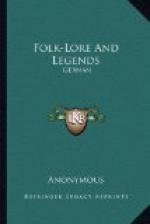That night, as luck wad have it, some thieves cam’ to steal the bees’ skeps, and in the hurry o’ tumbling them into a large grey plaid, they tumbled Jock in alang wi’ them. So aff they set, wi’ Jock and the skeps on their backs. On the way, they had to cross the burn where Jock lost his bonnet. Ane o’ the thieves cries, “Oh, I hae fand a bonnet!” and Jock, on hearing that, cries out, “Oh, that’s mine!” They thocht they had got the deil on their backs. So they let a’ fa’ in the burn; and Jock, being tied in the plaid, couldna get out; so he and the bees were a’ drowned thegither.
If a’ tales be true, that’s nae lee.
SAINT COLUMBA.
Soon after Saint Columba established his residence in Iona, tradition says that he paid a visit to a great seminary of Druids, then in the vicinity, at a place called Camusnan Ceul, or Bay of Cells, in the district of Ardnamurchan. Several remains of Druidical circles are still to be seen there, and on that bay and the neighbourhood many places are still named after their rites and ceremonies; such as Ardintibert, the Mount of Sacrifice, and others. The fame of the Saint had been for some time well known to the people, and his intention of instructing them in the doctrines of Christianity was announced to them. The ancient priesthood made every exertion to dissuade the inhabitants from hearing the powerful eloquence of Columba, and in this they were seconded by the principal man then in that country, whose name was Donald, a son of Connal.
The Saint had no sooner made his appearance, however, than he was surrounded by a vast multitude, anxious to hear so celebrated a preacher; and after the sermon was ended, many persons expressed a desire to be baptized, in spite of the remonstrances of the Druids. Columba had made choice of an eminence centrally situated for performing worship; but there was no water near the spot, and the son of Connal threatened with punishment any who should dare to procure it for his purpose. The Saint stood with his back leaning on a rock; after a short prayer, he struck the rock with his foot, and a stream of water issued forth in great abundance. The miracle had a powerful effect on the minds of his hearers, and many became converts to the new religion. This fountain is still distinguished by the name of Columba, and is considered of superior efficacy in the cure of diseases. When the Catholic form of worship prevailed in that country it was greatly resorted to, and old persons yet remember to have seen offerings left at the fountain in gratitude for benefits received from the benignant influence of the Saint’s blessing on the water. At length it is said that a daughter of Donald, the son of Connal, expressed a wish to be baptized, and the father restrained her by violence. He also, with the aid of the Druids, forced Columba to take refuge in his boat, and the holy man departed for Iona, after warning the inhospitable Caledonian to prepare for another world, as his life would soon terminate.




